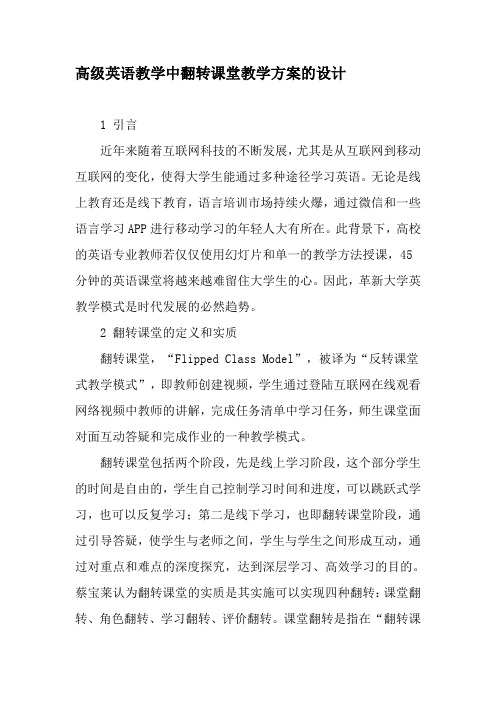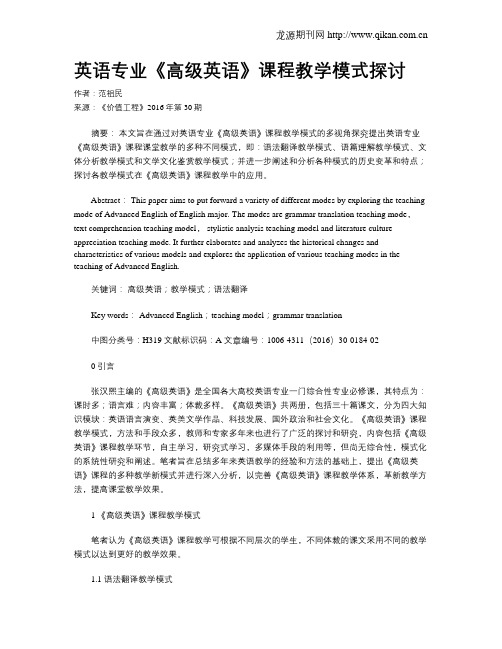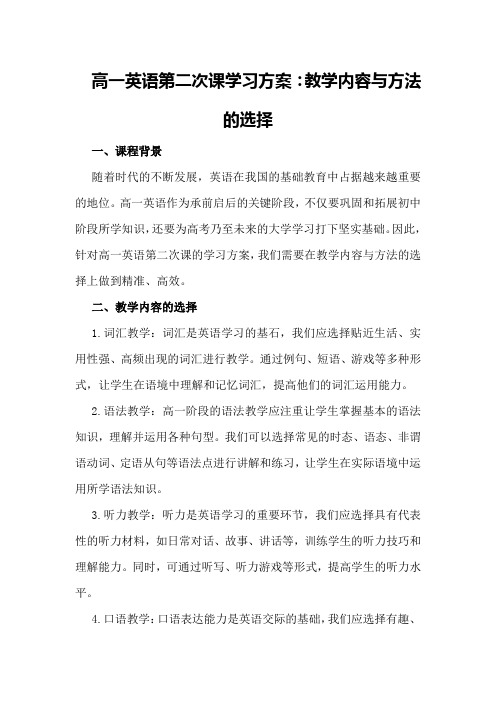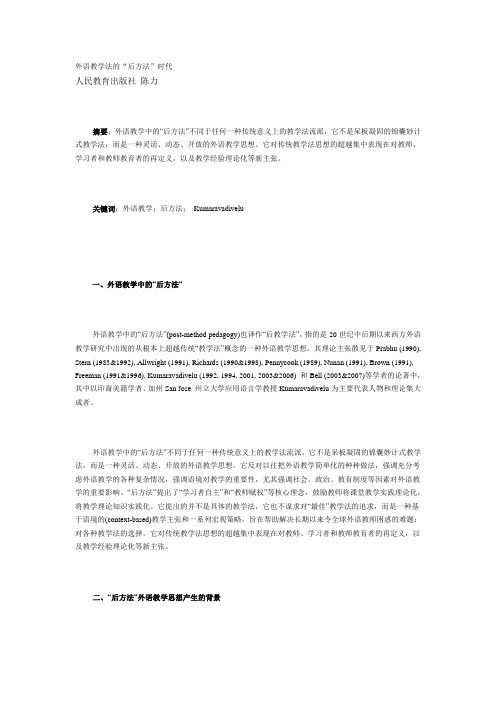后方法时代高级英语课程教学
“后方法时代”外语教学理念发展简述

二、教学质量和效果的提升
在后方法时代,外语教学理念的发展为提高教学质量和效果提供了新的视角 和方法。首先,教师不再局限于单一的教学方法,而是根据学生的实际情况和教 学目标灵活选择合适的教学方法。例如,教师可以根据教学内容和学生需求采用 交际法、任务法、项目法等多种教学方法。其次,教师更加注重学生的参与度和 自主学习能力的培养。
在理论框架部分,我们将首先简要介绍后方法时代教学理论。这一理论强调 英语教学不应该局限于任何一种固定的教学方法,而是应该根据学习者的个体差 异、学习风格和实际需求来灵活选择和调整教学方法。后方法时代教学理论对英 语学习的启示在于,英语教学应该注重培养学习者的自主学习能力、语言综合运 用能力和跨文化交际能力。
未来,随着科技的进步和社会的发展,外语教学将面临更多的机遇和挑战。 在后方法时代背景下,外语教学应继续秉持多元化、个性化和实用性的教学理念, 积极探索创新的教学方法和手段,以适应时代的需求和发展。外语教学也需要不 断学生的全面发展,培养具有国际视野和跨文化交际能力的优秀人才,为推动全 球化和文化交流做出积极的贡献。
四、结论
总之,后方法时代的外语教学理念为提高教学质量和效果提供了新的视角和 方法。通过强调多元化、个性化和实用性的教学理念,教师能够更好地满足不同 学生的学习需求,提高他们的学习兴趣和积极性,培养他们的语言实际运用能力。 教师也需要不断反思自己的教学实践,克服挑战和问题,不断完善和发展新理念 下的外语教学。
通过组织课堂讨论、角色扮演、小组合作等活动,激发学生的学习兴趣和积 极性,提高他们的语言实际运用能力。
此外,后方法时代的教学理念还强调反思性教学和教师专业发展。教师需要 不断反思自己的教学实践,根据学生的反馈和教学效果调整教学策略,不断学习 和掌握新的教学理论和方法,以适应不断变化的教学环境和满足学生的学习需求。
高级英语教学中翻转课堂教学方案的设计-2019年精选文档

高级英语教学中翻转课堂教学方案的设计1 引言近年来随着互联网科技的不断发展,尤其是从互联网到移动互联网的变化,使得大学生能通过多种途径学习英语。
无论是线上教育还是线下教育,语言培训市场持续火爆,通过微信和一些语言学习APP进行移动学习的年轻人大有所在。
此背景下,高校的英语专业教师若仅仅使用幻灯片和单一的教学方法授课,45分钟的英语课堂将越来越难留住大学生的心。
因此,革新大学英教学模式是时代发展的必然趋势。
2 翻转课堂的定义和实质翻转课堂,“Flipped Class Model”,被译为“反转课堂式教学模式”,即教师创建视频,学生通过登陆互联网在线观看网络视频中教师的讲解,完成任务清单中学习任务,师生课堂面对面互动答疑和完成作业的一种教学模式。
翻转课堂包括两个阶段,先是线上学习阶段,这个部分学生的时间是自由的,学生自己控制学习时间和进度,可以跳跃式学习,也可以反复学习;第二是线下学习,也即翻转课堂阶段,通过引导答疑,使学生与老师之间,学生与学生之间形成互动,通过对重点和难点的深度探究,达到深层学习、高效学习的目的。
蔡宝莱认为翻转课堂的实质是其实施可以实现四种翻转:课堂翻转、角色翻转、学习翻转、评价翻转。
课堂翻转是指在“翻转课堂式教学模式”下,学生在课堂外通过视频完成教学任务单的学习,而课堂变成了教师与学生之间和学生与学生之间互动的场所,包括答疑解惑、知识和技能的运用等,为自主和高效学习创造条件。
本文拟从第一个角度即课堂的翻转为切入点,以张汉熙编著的《高级英语》课本中收录的课文《马拉喀什见闻》为研究对象,探讨高级英语课堂的教学方案的设计。
3 翻转课堂的教学方案设计课堂翻转的教学方案的一个最重要的环节是学习任务单设计,学习任务单也称导学案,在学生登录网络平台进行视频学习之前,教师应针对课程单一的基本知识、基本技能、重难点、首先设计出学习任务清单。
任务单的内容是结构化的,应该包括:视频学习的基本知识点、重点和难点;学习任务的完成水平及再现检测的达标要求;辅助学习资源及获取途径。
高级英语课程教案第二册第四课

Reference Books 1.The New Book of Knowledge2.Encyclopedia Britannica3.Encyclopedia Americana4.Any History of the U.S covering the 1960’s5.Any biographical sketch of John F. Kennedy附页附页Question 3A piece of News 附页附页1. John F. Kennedy (1917--1963), 35th President of the United StatesA. His family backgroundJohn Kennedy, whose ancestors came from Ireland, was the first Roman Catholic to become president of the United States. At 43 he was also the youngest man ever elected to the highest office of his country, although he was not the youngest to serve in it. Theodore Roosevelt was not quite 43 when the assassination of President McKinley elevated him to the Presidency.John Fitzgerald Francis Kennedy was born on May 29, 1917 in Brookline, Massachusetts. Brookline was the suburb of Boston where his grandfather had been elected to many public offices. Joseph P. Kennedy, father of the future president, was at 25 the youngest bank president in the country. He was to build one of the great private fortunes of his time. He and Rose Fitzgerald Kennedy raised a family of nine children. John was the second born.When the first Kennedy child, Joseph, Jr., was born, father Joe was reported to have said, “He’ll be the first Kennedy to become president of the United States.” But he was killed while piloting a bomber in World War II, and the leadership of the rising Kennedy generation passed to John.Thus young John Kennedy, often called Jack, inherited a background of politics, wealth and determination. The family circle was close and warm. The boys learned competition first in sports. They, played hard to win, a family trait in sports and politics all their lives. Young Kennedy attended private schools in Brookline and New York City; and then in 1931, he entered Choate School, in Wallingford, Connecticut to prepare for college, Young Kennedy, after a short spell at the London School of Economics and Princeton, entered Harvard. In 1940 he graduated from Harvard cum lauds.B. His political career and election as presidentIn 1945 the Hearst newspapers hired Kennedy to cover the United Nations preliminary conference in San Francisco. He covered the British elections that year, then decided he had had enough of journalism. He did not know whether he would like politics, but decided to try it. In 1946 he ran for Congress as a Democrat, in a Boston district. Though he did not live there, Kennedy, by hard campaigning, defeated a large field of rivals. He was re-elected twice. Then he tried for election to the United States Senate against Republican Henry Cabot Lodge, who was supposed to be unbeatable in Massachusetts. It was a big Republican year in 1952, in Massachusetts and elsewhere, but Jack Kennedy beat Lodge by 70,000 votes.On September 12, 1953, Kennedy and Jacqueline Bouvier were married at Newport, Rhode Island. They had three children-Caroline; John, Jr., whom his father called John-John; and Patrick Bouvier, who lived but a few days.Kennedy missed being nominated for vice-president by a few votes in 1956. But he gained an introduction to millions of Americans who watched the Chicago Democratic Convention on television. When he decided to run for president in 1960, his name was widely known. Many thought that his religion and his youthful appearance would handicap him. Kennedy faced the religion issue frankly. He declared his firm belief in the separation of church and state. His wealth enabled him to assemble a staff and to get around the country in a private plane.Kennedy’s four television debates with Republican candidate, Richard M. Nixon, were a highlight of the 1960 campaign. The debates probably were important in Kennedy’ s close victory--303electoral votes to 219 for Nixon. The popular vote was breathtakingly close; Kennedy received only 18,574 more votes than Nixon--a fraction of 1 percent of the total vote.(excerpts from the New Book of Knowledge)C. AssassinationIn November 1963, President Kennedy journeyed to Texas for a speech-making tour. In Dallas on November 22, he and his wife were cheered enthusiastically as their open car passed through the streets. Suddenly, at 12:30 in the afternoon, an assassin fired several shots, striking the president twice, in the base of the neck and the head, and seriously wounding John Connally the governor of Texas, who was riding with the Kennedys. The president was rushed to Parkland Memorial Hospital, where he was pronounced dead about a half hour later. Within two hours, Vice president Johnson took the oath as president.On November 24, amid national and worldwide mourning, the President’s body lay in state on the rotunda of the U. S. Capitol. The next day, leaders of 92 nations attended the state funeral, and a million persons lined the route as a horsedrawn caisson bore the body to St. Matthew’s Cathedral for a requiem mass. While millions of Americans watched the ceremonies on television, the president was buried on an open slope in Arlington National Cemetery. There an eternal flame(常明火), lighted by his wife marks the grave.On the day of the assassination, the police arrested Lee Harvey Oswald, a 24-year-old ex-marine, for the president’s murder. Oswald, who had lived for a time in the Soviet Union, killed Dallas policeman J.D. Tippit while resisting arrest. Two days later, in the basement of the Dallas police station, Oswald himself was fatally shot by Jack Ruby, a nightclub owner.On November 29, President Johnson appointed a seven-member commission, headed by Chief Justice Earl Warren, to conduct a thorough investigation of the assassination and report to the nation. The commission’s report made public on Sept. 27, 1964, herd that Oswald fired the shots that killed the president. Further, to allay suspicions that the murder was a conspiratorial plot, it stated that the committee “found no evidence” that either Oswald or Ruby “was part of any conspiracy, domestic or foreign, to assassinate President Kennedy.”(from Encyclopedia Americana )2. InaugurationA. Inauguration Day:On April 30, 1789, George Washington stepped onto a balcony of Federal Hail in New York City, placed his hand on a Bible and swore to “preserve, protect and defend the Constitution of the United States. He then read an earnest speech, calling for “united and effective government”. Thus began a unique American institution--Inauguration Day--those dramatic hours when a new president faces the people for the first time.From 1793 until 1933 the induction of the new president was scheduled for noon on March 4, every fourth year. Under the 20th Amendment to the U. S Constitution it has taken place on January 20 since 1937. (Zachary Taylor was sworn in on March 5, 1849, to avoid taking the oath on Sunday.)The presidential oath, traditionally administered by the chief justice, is prescribed in Article II, section 1, of the Constitution. The incoming vice-president takes a similar oath. The ceremonies attending the swearing-in are extra-constitutional. Presidents who succeeded to the office on the death of the incumbent have been sworn in speedily and without ceremony.B. Inaugural Addresses: Memorable words have been uttered in inaugural addresses. In 1801, Thomas Jefferson called on a divided nation to uphold the basic principle of democracy, “absolute acquiescence in the will of the majority.” Abraham Lincoln, in 1861, warned the Southern states not to secede, appealing to “the mystic cords of memory, stretching forth from every battlefield and patriot grave.” In 1933 Franklin D. Roosevelt told Depression-racked Americans that” the only thing we have to fear is fear itself.” in 1961, John F. Kennedy said, “My fellow Americans: ask not what your country can do for you--ask what you can do for your country.”James Monroe, speaking from the steps of the Capitol, delivered the first outdoor inaugural address in 1871. Since then only the inauguration of William Howard Taft during a blizzard in 1909 has been held indoors.Not all inaugural speeches have been a success. Martin Van Buren was overshadowed by the outgoing president Andrew Jackson, and the crowd barely listened to him. Franklin Pierce, in 1853, tried in vain to make himself heard above a howling snow-storm. Rutherford B. Hayes, winner of the disputed election of 1876, had to endure boos, catcalls, and assassination threats.Some presidents contributed personal touches to the ceremony. Washington added to his oath “so help me God,” and kissed the Bible. In 1905, Theodore Roosevelt wore a ring containing a lock of hair cut form Lincoln’s head after he was shot. In 1937, Franklin D. Roosevelt rode bareheaded down Pennsylvania Avenue in an open car, sharing the driving rain with the spectators.C. The Inaugural Parade and Ball: The inaugural parade had grown from several hundred marchers to the record 40, 000 persons who walked past Woodrow Wilson in 1931. In 1965, Lyndon B.Johnson limited marchers to 15,000. Mrs. James Madison began thetradition of an inaugural ball in 1809. In 1809 some 6,000 peoplebought tickets to Ulysses S. Grant’s inaugural ball, and a near riotensued when the ball could not accommodate them. The ball hasgrown to such proportions that it is divided among four o fiveballrooms in Washington.(from Encyclopedia Americana)附页附页3Text Analysis (Brief))Introduction tothe Passage1.Type of literature: political speech2.Object of a political speech:--to explain--to convince--to persuade3.Well organized and highly rhetorical4.Biblical style/language5.Often-quoted passagesEffective Writing Skills 1.Employing suitable rhetorical devices and words to create thedesired emotional impact2.clear order and appropriate tone to the different groups heis addressing3.Employing Biblical style deliberatelyRhetorical Devices 1.metaphor2.antithesis1.parallelism2.repetitionSpecial Difficulties 1. Biblical language/quotations/styleing the following methods for force, vividness and emotionalappeal:--Parallel and balanced structure--Repetition of important words--Antithesis3.Paraphrasing some sentences4.Identifying figures of speech 附页3The object of a political speech is to explain, convince and persuade the people that what he is saying and planning to do best represents their interests so they should support him. As president of the United States, Kennedy has to address a world- wide audience. He has to appeal not only to the American people but also to the different groups of nations in the international community.In order to understand and evaluate his speech better, we should also bear in mind that he became president during the cold war period when the world was divided into two hostile camps. The message of the address is clear. The United States, the self-appointed leader of the “free democracies”, is prepared to pay any price to defend human rights and the liberty and independence of free nations, so these nations should support and accept the leadership of the United States. There is veiled threat, warning and advice to the enemy camp. She is prepared to “oppose any foe” and “dare not tempt them with weakness”, so they should negotiate and cooperate.This speech is well organized and highly rhetorical. It is mostly persuasionwith very little explanation. As the address is generally short it has to rely chiefly on a successful appeal to emotions for it does not have time enough to cite facts and reasons which could convince. To do this successfully, the speaker must first understand the psychology of the audience to whom he is directing his words and then employ suitable rhetorical devices and words to create the desired emotional impact. The first five paragraphs of this speech is a general statement of basic policy goals. In paragraphs 6 to 9 he addresses different groups of allied nations or would-be allies. In 11--19 he speaks to his enemy. Finally he appeals to his countrymen for support and sacrifice. The order is clear and the tone appropriate to the different groups he is addressing.Besides figures of speech and the appropriate use of words, parallel and balanced structures, repetition of important words and phrases, and antithesis are employed for force, vividness and emotional appeal. Paras 6, 7, 8, 10, and 11 begin with the same type of phrases: “To those old allies...”, “To those new States...”, “To those peoples”, “To our sister republics...”, “To that world assembly...”and “to those nations... “. Paras15, 16, 17, 18 begin with the same type of phrases: “Let both sides...”. Besides these, there are many other examples of parallel structures. As for repetition of important words we have: all forces” and “belief” (para. 2); “committed” (para. 3);”good” and “free” (para. 9), etc. Finally antithesis is also often used for force and vividness, e.g. “United, there is little ...Divided, there is little...(para.. 6);” If a free society cannot who are rich.” (para.. 8); and “Let both sides explore... divide us.” (para.. 15).Another point that one notices is Kennedy’s deliberate use of a pseudo-Roman style or Biblical language in some places. Perhaps, he thinks this kind of language adds solemnity to some of his weightier sayings. Here are some examples that illustrate this point:1) And yet the same revolutionary belief for which our forbears fought is still at issue around the globe, the belief that the rights of man come not from the generosity of the state but from the hand of God. (para. 2)2) Let the word go forth from this time and place... (para. 3)3) to strengthen its shield of the new, and to enlarge the area in which its writ may run. (para. 10)4) And so, my fellow Americans ask not what... your country. (para. 25)Persuasion based on emotional appeal can be successful only on special occasions for it does not put forward sufficient facts and reasons to convince. It can be successful when the audience is excited and does not have much time to think or when the audience is already susceptible to the message of the speaker. Political demagogy, however, relies on emotional appeal for its success.。
英语专业《高级英语》课程教学模式探讨

英语专业《高级英语》课程教学模式探讨作者:范祖民来源:《价值工程》2016年第30期摘要:本文旨在通过对英语专业《高级英语》课程教学模式的多视角探究提出英语专业《高级英语》课程课堂教学的多种不同模式,即:语法翻译教学模式、语篇理解教学模式、文体分析教学模式和文学文化鉴赏教学模式;并进一步阐述和分析各种模式的历史变革和特点;探讨各教学模式在《高级英语》课程教学中的应用。
Abstract: This paper aims to put forward a variety of different modes by exploring the teaching mode of Advanced English of English major. The modes are grammar translation teaching mode,text comprehension teaching model, stylistic analysis teaching model and literature culture appreciation teaching mode. It further elaborates and analyzes the historical changes and characteristics of various models and explores the application of various teaching modes in the teaching of Advanced English.关键词:高级英语;教学模式;语法翻译Key words: Advanced English;teaching model;grammar translation中图分类号:H319 文献标识码:A 文章编号:1006-4311(2016)30-0184-020 引言张汉熙主编的《高级英语》是全国各大高校英语专业一门综合性专业必修课,其特点为:课时多;语言难;内容丰富;体裁多样。
高一英语第二次课学习方案:教学内容与方法的选择

高一英语第二次课学习方案:教学内容与方法的选择一、课程背景随着时代的不断发展,英语在我国的基础教育中占据越来越重要的地位。
高一英语作为承前启后的关键阶段,不仅要巩固和拓展初中阶段所学知识,还要为高考乃至未来的大学学习打下坚实基础。
因此,针对高一英语第二次课的学习方案,我们需要在教学内容与方法的选择上做到精准、高效。
二、教学内容的选择1.词汇教学:词汇是英语学习的基石,我们应选择贴近生活、实用性强、高频出现的词汇进行教学。
通过例句、短语、游戏等多种形式,让学生在语境中理解和记忆词汇,提高他们的词汇运用能力。
2.语法教学:高一阶段的语法教学应注重让学生掌握基本的语法知识,理解并运用各种句型。
我们可以选择常见的时态、语态、非谓语动词、定语从句等语法点进行讲解和练习,让学生在实际语境中运用所学语法知识。
3.听力教学:听力是英语学习的重要环节,我们应选择具有代表性的听力材料,如日常对话、故事、讲话等,训练学生的听力技巧和理解能力。
同时,可通过听写、听力游戏等形式,提高学生的听力水平。
4.口语教学:口语表达能力是英语交际的基础,我们应选择有趣、实用的口语话题,让学生在讨论、角色扮演等活动中,提高口语表达能力和思维能力。
5.阅读教学:阅读理解能力是英语学习的重要技能,我们应选择具有代表性的阅读材料,如故事、说明文、议论文等,训练学生的阅读技巧和理解能力。
同时,可通过词汇填空、阅读理解游戏等形式,提高学生的阅读水平。
6.写作教学:写作是英语学习的输出环节,我们应选择具有实际意义的写作话题,让学生在写作过程中,学会运用所学词汇和语法知识,提高写作能力和思维能力。
三、教学方法的选择1.任务型教学法:通过设计各种实际任务,让学生在完成任务的过程中,运用所学知识和技能。
这种教学法有利于激发学生的学习兴趣,提高他们的实践能力。
2.情境教学法:通过创设真实的语境,让学生在交流、互动的过程中,自然地学习和掌握英语知识。
这种教学法有利于提高学生的语言运用能力和思维能力。
外语教学法的后方法时代

外语教学法的“后方法”时代人民教育出版社陈力摘要:外语教学中的“后方法”不同于任何一种传统意义上的教学法流派,它不是呆板凝固的锦囊妙计式教学法,而是一种灵活、动态、开放的外语教学思想。
它对传统教学法思想的超越集中表现在对教师、学习者和教师教育者的再定义,以及教学经验理论化等新主张。
关键词:外语教学;后方法;Kumaravadivelu一、外语教学中的“后方法”外语教学中的“后方法”(post-method pedagogy)也译作“后教学法”,指的是20世纪中后期以来西方外语教学研究中出现的从根本上超越传统“教学法”概念的一种外语教学思想,其理论主张散见于Prabhu (1990), Stern (1983&1992), Allwright (1991), Richards (1990&1998), Pennycook (1989), Nunan (1991), Brown (1991), Freeman (1991&1996), Kumaravadivelu (1992, 1994, 2001, 2003&2006) 和Bell (2003&2007)等学者的论著中,其中以印裔美籍学者、加州San Jose 州立大学应用语言学教授Kumaravadivelu为主要代表人物和理论集大成者。
外语教学中的“后方法”不同于任何一种传统意义上的教学法流派,它不是呆板凝固的锦囊妙计式教学法,而是一种灵活、动态、开放的外语教学思想。
它反对以往把外语教学简单化的种种做法,强调充分考虑外语教学的各种复杂情况,强调语境对教学的重要性,尤其强调社会、政治、教育制度等因素对外语教学的重要影响。
“后方法”提出了“学习者自主”和“教师赋权”等核心理念,鼓励教师将课堂教学实践理论化,将教学理论知识实践化。
它提出的并不是具体的教学法,它也不谋求对“最佳”教学法的追求,而是一种基于语境的(context-based)教学主张和一系列宏观策略,旨在帮助解决长期以来令全球外语教师困惑的难题:对各种教学法的选择。
国家级精品课程《高级英语》课程建设方案

国家级精品课程《高级英语》课程建设方案一、建设目标:用五年时间,把高级英语建设成为一门充分践行“学生本位”、“素质本位”思想,人文色彩浓郁,时代内涵丰富,教学方法创新,教学手段先进,教学环境信息化特色突出,课程评价体系完善,自我革新能力强的高年级“核心”课程.二、建设步骤:本课程建设将在多项“分目标”同时并举的基础上,采取分层次、有优先、有重点、逐年推进的建设方略。
具体规划如下:1。
人文及时代内涵建设(1)本课程组刚刚编写、出版的《新编高级英语教程》取材广泛,选材新颖,时代性强,人文内涵丰富,这为本课程实现未来5年的“人文及时代内涵”建设目标打下了坚实的基础。
(2)适时引入、编写一批教辅、学辅材料,进一步扩充本课程人文内涵,保持其时代性。
(3)在课堂教学中,充分挖掘现有教材的人文内涵,探索有利于培养学生人文素养和科学创新精神的授课形式。
(4)将对学生人文、科学精神的培养作为设计、开展实践课教学的基本要求之一。
2.教学环境信息化建设(1)“高英”课堂教学网建设:A. 完善并适时更新现有的电子资料库——CAI 课件,背景知识、作者简介、语言知识点、文本赏析、注释、相关话题导引、习题、试题等教辅、学辅材料;B. 逐步实现课程全部模块授课录像并上网;C。
在现有朗文、韦氏、金山词霸等在线词典的基础上,再投放几部高质量的网络词典;D。
建设网上学习资料下载平台.(2)校园网、局域网建设与利用:A。
进一步拓展校园网的“资源"功能;B。
开展网上资源利用研讨活动;C. 进一步发掘Internet网上学习资源,提供具体链接地址。
(3)在线语料库建设:A。
探索能充分利用现有BNC、BROWN,LOB,LDC等在线语料库的教学新形式;B。
适时购进1-2个切合“高英"(及其它课程)教学、科研需要的国、内外语料库(尤其是英、汉平行语料库);C.力争自主建设1-2个切合本课程及其它多门课程教学、科研需要的校本语料库。
“新文科”背景下的英语专业课程教学模式改革与创新

245教育智库“新文科”背景下的英语专业课程教学模式改革与创新2017年,美国的希拉姆学院(Hiram College)首先提出了“新文科”理念,它主张用现代思维整合并调整传统文科,将新信息技术渗透到文学、艺术、历史等人文学科之中,快速提升学习者的综合能力。
2019 年“新文科”在我国正式启动,由教育部牵头,中科院、社科院等12个部门参与制定。
新文科理念主要体现在,一方面新文科将培育新的学科增长点。
把人工智能、大数据云计算等新技术有机地融入人文社会科学的学科体系构建,形成文理交叉、文工交叉的新文科专业体系。
另一方面新文科将改造升级传统学科。
结合人工智能技术,对文学、语言学、传播学、社会学等学科进行整合与升级,从多领域进行综合交叉研究,形成高效新文科建设的新格局。
由此可见数字人文给人文学科带来了挑战, 也让研究方法突破传统文学研究的路径。
国内新文科发展综述近20年以来,国外的数字人文发展较快,有很多研究机构,是建立在数据库的基础之上,用多模态人工智能技术来识别他们在系统中的高层努力和低层特征之间的一些很多问题,比如像美国民族大学建立了一个语言数据联盟,他目前所拥有的语言资源和规模就已经达到了565种,用这个用多模态人工智能的技术,进行识别,做一些相关的应用,开发相关的工具,包括在文学研究方面也同样的,比如斯坦福大学成立了一个实验室,它就率先实现了学科交叉,从数据库当中提取数据,通过对文学作品内容及相关情况的统计来判定作品的影响,辨啊识国别小说当中的差异等一些文学问题,举个例子来讲,比方说还有一项加拿大学者所做的研究就是通过统计歌德的《少年维特之烦恼》的文体特征,通过相关的算法测量出数据,算出同时代的欧洲小说和歌德小说在形式上的一种相似性,来判定这个文学作品的影响,这对比较文学的研究方面是非常有效的一种路径。
2003年,我们国家也成立了中国语言资源联盟,目前的语言资源规模也要有上百种,而且国内很多学者也从本体论、认识论和方法论这些方面来阐述人工智能时代认知语言学的特点和研究形式,更好地解决语言学的生存问题,打开了新的研究事业,国内在文学方研究方面,实际上已经开始了运用这个大数据来来进行这个某一门类的研究,比方说在中国语言文学研究方面,包括在中国的文化传播研究方面,其实反而走在外国文学研究的前面,如古典文学研究数据,还有大数据时代的新媒体研究等等都能够提供一种新的方法和视角。
- 1、下载文档前请自行甄别文档内容的完整性,平台不提供额外的编辑、内容补充、找答案等附加服务。
- 2、"仅部分预览"的文档,不可在线预览部分如存在完整性等问题,可反馈申请退款(可完整预览的文档不适用该条件!)。
- 3、如文档侵犯您的权益,请联系客服反馈,我们会尽快为您处理(人工客服工作时间:9:00-18:30)。
一、前言20世纪中后期,受后现代主义思潮影响,西方外语教学研究从“教学法”时代逐渐过渡到“后方法”(post-methodpedago-gy)时代,研究重点从对“方法”的探讨逐步扭转为对“途径”的摸索,即从追求教学方法的改革、寻求最佳教学法等方面转移到教学过程与教学效果众多影响因素的分析,同时重新定义了教学参与者的身份、设定了基本参量、也制定了外语教学的相关策略。
这股理论研究新思潮为我国二语习得研究大讨论提供了崭新的视角,也为我国英语专业技能必修课——高级英语课程的教学改革研究提供了一条新的发展思路。
二、“后方法”时代西方外语教学研究核心理念语法翻译法在西欧国家确定其统治地位后的一百多年里,一直都备受国内外应用语言学者和外语教学研究者的关注,相关理论流派层出不穷。
然而,究竟哪种教学法最有效、最具有普适性,人们的观点莫衷一是。
随着大量定性研究和教学实践的开展,越来越多的学者和外语教师发现,对教学法的幼稚盲从和对“最佳教学法”的执拗寻求已将外语教学研究带入误区,过多关注教学方法的多元性和开放性,而忽略了其相对性和特定性。
国外学者Stern首先认识到了以往外语教学理论研究的局限性,提出外语教学三维框架,着手分析外语教学环节中的诸多因素,将教师视为教学研究、实践和理论研究的综合体,充分肯定了教师的主动性和创造性,打破了之前视教师为教学理论被动接受者和刻板执行者的思维定式。
他认为,研究和实践的重点应放在师生对语言课堂生活质量的理解上,而不是输出质量的简单考察,教学的本质是个互动性的多元交往过程。
Kuma-ravadivelu将宏观策略框架与上两位学者的主要观点相结合,整理出经典的“后方法”外语教学理论框架,即以教师自主为核心,以特定性、实践性和社会可行性为原则,“鼓励教师建构自己的教学理论,推动基于对当地语言、社会文化和政治特征正确理解之上的语境语言教学”。
三、“后方法”时代下的高级英语课程特征分析1.高级英语课程属性。
高级英语是英语专业高年级的一门必修课,是基础阅读课的深化和延伸。
它与综合英语课程的不同之处在于:(1)教材选取文章多为名篇佳作,且内容多样、题材广泛、视角开阔,语言文字更地道凝练,具备较强的思想深度,注重东西方文化的介绍和传播;(2)注重学生综合英语技能的培养,除语言运用、对美文佳作的分析鉴赏、逻辑思维等能力外,更强调了“获取知识—运用知识—分析问题—独立提出见解—创新”能力链条的建构;(3)对教师的综合素质提出了更高的要求。
教师不仅需具备驾驭语言文化的能力,还需要统筹教学环节,要学会引领学生深入探索思辨。
2.教学对象特点以及市场需求。
高级英语课程的授课对象是高校英语专业大三、大四的学生,经过前两年的学习,学生应已具备较扎实的语言基本功、积累了一定的跨文化知识,并在综合能力和素质方面得到了锻炼。
在接下来的两年里,他们必须进一步奠定坚实的语言基础、完善英语应用能力,并努力提升包括知识面、分析解决问题的能力、思想道德素质、专业素质、身心素质等在内的核心竞争力,以顺应社会的需求,迎接未来的挑战。
他们的学习需求、个人发展需求和社会需求密切联系,在英语专业学生的未来工作中,知识和技能的高效输出能力是用人单位极为重视的,因而学校在教学中应着重此方面的训练。
3.教师特征和定位。
“后方法”时代背景下,外语教学的理论研究呈现出日益浓厚的人本主义取向,外语教师的个人特征、发展和需求受到了前所未有的关注,其中对教师的信念研究、教学文化情境、教师行动研究等是目前研究的热点。
近些年,高教体制中对教师教学能力和学术能力的双重要求和较高的考核标[摘要]外语教学理论研究已进入“后方法”时代,研究重点已不再拘泥于过去具体的教学法,而应着重从宏观的教学策略和途径探索出发。
文章以此为视角,基于对课程属性、师生双方特征和现实需求的角度展开分析,同时结合国内外相关理论成果,试提出一些适合我国高级英语课程的教学策略。
[关键词]高级英语课程“后方法”时代教学策略[作者简介]谢峤(1983-),女,天津人,天津理工大学外国语学院,讲师,硕士,研究方向为应用语言学与外语教学。
(天津300191)[课题项目]本文系天津市高等学校人文社会科学研究项目“后方法时代高校大规模英语课堂教学策略与管理模式建构研究”(项目编号:20112201)和天津理工大学教学改革项目“《大学英语》大班教学策略与课堂管理模式研究”(项目编号:YB11-51)的阶段性研究成果。
[中图分类号]G642.3[文献标识码]A[文章编号]1004-3985(2012)36-0140-02“后方法”时代高级英语课程教学研究谢峤准,使得英语专业教师之间的合作日益广泛,竞争也日趋激烈,这些都或多或少地影响了高级英语教师的发展和需求。
此外,由于高级英语课程的重点之一在于东西方文化的引进和介绍,因而,一方面,教师作为文化中介,需要树立积极恰当的文化价值观,在传授背景知识和跨文化知识的同时,需要注意中华本土文化的传承和发扬,真正做到学贯东西;另一方面,教师应注重自身的文化立场,对不同的文化平等对待,兼容并蓄,在中西方文化的交融中找到自身的平衡点。
此外,在英语专业教学改革的大背景下,教师不能只满足于语言文化知识教学者与实践者这一单向的身份,还需要通过不断的反思,与理论研究者一起积极投身于外语教学理论的建构和改革。
四、“后方法”时代的高级英语课程教学策略1.以人为本,注重教学双方特定性。
近些年,英语专业教师已逐渐摆脱“课堂教学主宰者”的固有形象,转变成课堂教学的组织者、参与者以及学生学习的指导者,“以学生为中心”的教学思想贯穿整个课堂教学过程。
然而,在开展教学活动前,许多教师个体常根据教参和成品课件,结合个人教学经验编纂教案,将“教”作为行动的单一出发点,忽略了同行和学生群在教案设计中的重要角色。
为了扭转这一旧有模式并充分体现“以人为本”的核心教学理念,学校可采取教师集体备课或学生提议、师生探讨等多种互动形式,综合教师群的集体教学经验和学生群的实际水平安排教学重点和教学环节。
2.语意与形式并重,语言与文化兼顾。
经过两年的学习,英语专业高年级学生已对英语语言形式有了较完备的了解和把握,但这并不意味着教授高级英语课程时,教师应一味地注重语言内容和意义,割裂两者间的密切关系。
上世纪的西方外语教学理论研究经历了从纯形式教学(如语法翻译法)到纯意义教学(如浸入式教学法)的两个极端,但随着理论研究和教学实践的深入,目前主流的教学理论多集中在这两个极端之间的某个位置。
如MichaelLong的FocusonForm(语意和形式兼顾)理论,这一理论的主要思想是:当学生在课堂教学过程中出现对某一个语言形式的理解或表达的困难时,教师应随时将学生的注意力引向这个语言形式,加以讲解,但教学的重点应仍是语言的交际活动。
此外,教师还要充分考虑到高级英语课程的属性和学生的需求,教师在教授语言知识的同时,必须要兼顾学生跨文化能力的培养。
从根本上讲,这是一种素质训练,而非技能训练;是潜能全面发展意义上的education,不是training。
在教学过程中,教师要因地制宜采取必要的教学方法,整合丰富的教学资源,成为语言和文化的教育者。
3.注重输出驱动,培养综合能力。
英语专业毕业生的英语应用能力是用人单位考核的重点,对于即将走上工作岗位的外语类大学生而言,具备流畅的表达性技能尤为重要。
无论是口头交流还是书面交流,语言互动都是相互合作的过程,包括信息传递双方以及信息内容三方面的元素。
此外,语言的实际应用能力还牵涉到交流双方的逻辑思维、知识面、沟通互动、合作等多种综合技能,因此,高级英语课程教师应努力将课堂互动合作作为关键教学手段,培养学生的综合技能。
前文中所提到的凸显输出驱动效应的综合教学法便是实现这一目的的有效教学策略。
在教学过程中,教师应当设计各种活动,如围绕某篇课文进行主题演讲、撰写读书笔记、就课文经典段落进行口笔译、听相关材料写摘要、口头作文等模式训练学生的听、说、读、写、译等语言综合技能。
通过学生间评比、班级竞赛、互助小组、多维评价等多种形式促进师生、生生之间互动合作的积极性和教学效果,真正做到多种技能的共同开发和培养。
4.坚持教学反思,推动教研双向发展。
“后方法”时代的教师不仅是教学理论的实践者,更是教学理论的研究者和革新者。
作为教育事业的一线工作者,高级英语课程教师应培养反思思维能力,及时充分地反思教学过程,归纳总结教学经验,将其升华到理论高度,真正做到教研相长、相互促进。
由于教学活动是不断变化的,受教学双方教材以及教学环境等多种变量的影响,高级英语教师应随着教学过程的推进和理论知识的积累,进行动态反思和调整,保证教学和科研的实时转化。
此外,由于教学涉及人为因素,因此,为了保证反思的客观性和综合性,避免教师主观臆断,任课教师应以教学团队作为反思的活动单位,通过分享教学日志,开展经验交流会以及互相观摩等多种方式反思教学活动。
外语教学理论界长期以来试图挖掘一种具有普适性的教学方法以指导现实中的教学实践,却忽视了教师和学生在教学活动中的主体地位。
进入“后方法”时代后,教学环境的特殊性和复杂性、教学双方的属性和需求都得到了前所未有的重视。
正是在这一理念的指引下,作为理论和实践的接驳者,教师的身份得到了重新定义。
教师不仅需要分析影响教学的诸多因素,能因地制宜地开展教学,还需要能发挥主观能动性,成为教学理论的革新者。
所以,高级英语课程教师应潜心教学,从课程属性、师生特征和需求出发安排教学。
在具体教学内容方面,做到语言与文化并重、形式与意义兼顾,以综合技能输出为驱动,通过不断的反思和分析,改进教学实践,并将实践经验汇总,逐步上升到理论高度,实现教研的双向发展与相互促进。
[参考文献][1]陈力.外语教学法的“后方法”时代[J].基础英语教育,2009(6).[2]郝兴跃.外语教学法的动态发展研究[J].外语界,2001(2).[3]李银芳.对新时期英语专业教育的思考[J].高师英语教学与研究,2005(3).[4]文秋芳.输出驱动假设与英语专业技能课程改革[J].外语界,2008(2).[5]王奇民.制约大学英语教学效果的因素及对策[J].外语界,2002(4).[6]严明.后教学法时代在职外语教师研究取向述略[J].外语教学理论与实践,2010(2).[7]郑志恋.探索型实践:高校英语教师研究新视角[J].外语界,2009(1).[8]EllisR.Introduction:Investigatingform-focusedinstruction[J].Language Learning ,2001(15).[9]LongM.Focus on form:A design feature in language teaching methodology [M].Amsterdam:JohnBenjamins,1991.[10]PrabhuNS.Thereisnobestmethod--why?[J].TESOL Quarterly ,1990(24).[11]SternHH.Fundamental conceptions of language teaching [M].Oxford:OxfordUniversityPress,1983.。
